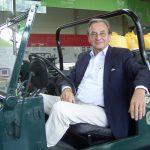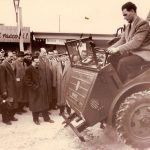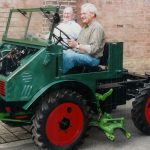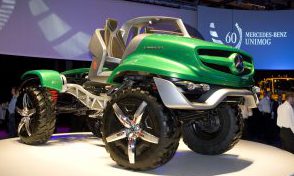About us
The success story of the Unimog-Club Gaggenau e. V.
The Unimog-Club Gaggenau e. V. is today an association of over 8,000 members in 48 countries. Michael Wessel, Honorary Chairman of the Unimog-Club Gaggenau e. V. (UCG), tells the founding story:
“For the establishment of the club was crucial surely that I bought a Unimog 2010, year 52, on the annual meeting of the Unimog Veteranen Clubs in Bad Laer from Alfred Menke in1992. That’s where I had actually gone to present my first book of the Geschichten rund um den Unimog.
Arriving at home, I approached Unimog owners and heard that they always wanted to meet at a regulars’ table. I wanted to make this wish come true: On two weekends I phoned for a few hours and then, according to the snowball system – everyone knew a few more Unimog owners – I collected about 100 addresses within a radius of 25 kilometres around Gaggenau. I invited these Unimog owners in March 1993 to the Gaggenauer Jahnplatz – and 40 came with their Unimog and another 20 without. The present Unimog-interested was fast clear: We found a Unimog-Regionalclub in Gaggenau. A regional club because the Unimog Veterans Club already existed and we didn’t want to compete with it.
On May 15, 1993 the time had come: We met at Westermann-Holzbau in Kuppenheim to initiate the foundation of the club, not to own a Unimog, but to be enthusiastic about this vehicle. This can also be expressed in the collection of Unimog models, stickers, advertising articles, literature or in the interest for the history of this all-round vehicle.
Among the founding members of the club was Hans-Jürgen Wischhof, head of the Unimog business unit of the then Daimler-Benz AG, himself a proud owner of an excellently restored Unimog 411 and a committed collector of Unimog models. Wischhof welcomed the initiative to found the club, “because the Unimog is such an enthusiastic vehicle that even after work is done, people like to spend their free time with it”.
We Gaggenauer are lucky to have many members who have known the Unimog inside and out for decades – for example the current honorary member Manfred Florus. In 1949, following his training as a qualified farmer at Boehringer in Göppingen, he began as an assembly worker in the Unimog assembly line and worked for the Unimog all his working life – most recently as export manager.
- Honorary member and former board member Heinz Schnepf has worked only for the Unimog since his apprenticeship over 40 years. He was with him in many European countries, in Asia, America and Africa. His last great experience in 1990 was the Paris-Peking Rally with a Unimog 1300 L with 240 hp. In four weeks, 18,000 kilometres had to be covered, sometimes under difficult conditions.
Roland Feix’s life was also largely determined by the Unimog: A Unimog brochure from 1948 fascinated him so much that he started as an assembly worker in the Unimog hall of Boehringer Maschinenfabrik in Göppingen in July 1949. He experienced the production of the “number 23”! More than 44 years he presented the Unimog at countless trade fairs and accompanied it on test drives and demonstrations in Argentina, Uruguay, Paraguay, Chile and Latin America.
The regional limitation originally intended for the counties of Rastatt and Baden-Baden could not be maintained. After all, we did not want to close ourselves off to Unimog friends from more distant regions who wanted to become members of our association.
The club could submit many attractive offers to its members since its existence. Thus journeys to Hohenheim, Mannheim and into the east Switzerland stood on the program, supplemented by employment demonstrations, model collector meetings, film evenings, work inspections, driver training courses and trials, trips, restoration courses and Schraubertreffen to special topics.
The rapid development of membership made it necessary to establish regional groups in Germany and neighbouring countries as early as 1994.
The first special event, however, was the big Unimog star ride to Gaggenau in 1995 on the occasion of 100 years of automobile construction in Gaggenau and 10 years of the Unimog Veterans Club. Good personal contacts were maintained with the Unimog Veterans Club from the very beginning, and so they gladly took over the organisation of this major event on site. Many large annual meetings, for example in the Offroad area in Aufenau near Bad Orb, followed.
 The quarterly membership information, the Unimog booklet Unimog-Heft’l , is very popular in the club. The Unimog friends will find reports, technical tips, Unimog classifieds, ideas of members, history and much more. You can find the success story of our club magazine Unimog-Heft’l in the rider of the same name on this homepage.
The quarterly membership information, the Unimog booklet Unimog-Heft’l , is very popular in the club. The Unimog friends will find reports, technical tips, Unimog classifieds, ideas of members, history and much more. You can find the success story of our club magazine Unimog-Heft’l in the rider of the same name on this homepage.
In the year 1997 the registration took place as “registered association” (registered association).
The first ideas for the establishment of aUnimog-Museums arose at the festive evening in 1998 in Steinmauern to mark the fifth anniversary of the association’s existence. At that time, Michael Wessel was the idea giver who found an active supporter in Hans-Jürgen Wischhof, in those days head of the Unimog product division.
In 1999, the UCG was admitted to the circle of officially recognized Mercedes-Benz brand clubs by Mercedes-Benz Classic. This was in recognition of the many years of successful club work.
We have been cooperating with the largest Unimog Internet portal www.unimog-community.de since 1999.
When it was clear that the Unimog production would be relocated from Gaggenau to neighbouring Wörth, the motto of the UCG board members Manfred Florus, Hans-Jürgen Schöpfer and Edwin Westermann was: “Now or never – we are building a Unimog museum!” They were the first working group to outline the key figures for this mammoth project. In addition to concrete ideas about the building, the exhibition programme, museum sponsors, supporters, equipment, admission fees and, of course, financing were discussed.
 In 2001, 50 years of Mercedes-Benz Unimog were celebrated in Gaggenau with the support of the UCG. More than 500 Unimog drivers drove their vehicles back to the place of origin. It was with a heavy heart that the Gaggenauer had to accept that the Unimog area would take place at the neighbouring Mercedes-Benz plant in Wörth from 2002.
In 2001, 50 years of Mercedes-Benz Unimog were celebrated in Gaggenau with the support of the UCG. More than 500 Unimog drivers drove their vehicles back to the place of origin. It was with a heavy heart that the Gaggenauer had to accept that the Unimog area would take place at the neighbouring Mercedes-Benz plant in Wörth from 2002.
Another highlight was the recognition of the UCG as a “non-profit association” by the Rastatt tax office on 7 June 2005.
The relocation of the Unimog production inspired the board members, so that the project “Unimog Museum” was forced thereupon with still more energy. On 5 November 2002, an independent, non-profit “Unimog Museum Association” was founded and UCG board member Hans-Jürgen Schöpfer was elected first chairman, Dieter Sellnau as deputy chairman and Jürgen Hirth as cashier. The inauguration of the Unimog Museum took place on 3 June 2006 (more at www.unimog-museum.com).
Due to the constantly growing number of members, an office was set up in 2008 to increase the service for the members and to relieve the board of directors.
From the foundation of the club in May 1993 until November 2008 I was the chairman of the UCG. Now it was time to rejuvenate the board. In the general meeting 2008 Michael Schnepf (secretary since the foundation) was elected as my successor. My board colleagues Roland Feix, Heinz Schnepf and Manfred Florus became UCG honorary members, I was awarded the title of honorary chairman.
 Michael Wessel
Michael Wessel
in December 2008
As the new first chairman – elected in November 2008 – Michael Schnepf continues the history of the UCG.
In June 2011, the next 60th anniversary of the Mercedes-Benz Unimog was celebrated at the Mercedes-Benz plant in Wörth and supported with a Unimog star ride and 60 selected vehicles from the Mercedes-Benz plant in Gaggenau to the Mercedes-Benz plant in Wörth.
“With Heft’l 50 it’s over,” Carl-Heinz Vogler once said, when it was still a long way off. Today we can be glad that he has produced 74 issues in 19 years for the UCG. Without this high quality magazine, the UCG would not have made this rapid development. A tremendous achievement worthy of the highest recognition. In June 2012, and after two years of preparation, our “Heft’l-Macher” handed over this task to his successor Michael Endres.
Carl-Heinz was unable to attend his farewell and appointment as honorary member at the general meeting in November 2012 for health reasons, so that we recorded his farewell in a film without further ado. Furthermore, his colleagues on the board and some persons involved in Unimog-Heft’l dedicated a very personal Unimog-Heft’l copy to Carl-Heinz.
At the general meeting in November 2013, Hans-Jürgen Schöpfer was accepted as an honorary member after 15 years and Edwin Westermann after 20 years on the board. Among other things, Hans-Jürgen Schöpfer supported the board in all legal questions and in questions concerning the Unimog models. We owe him the UCG archive we have today, which he built up over many years of meticulous work. Until his departure, Edwin Westermann organised countless supra-regional sub-markets as well as various other events and, as deputy in the regional group Mittelbaden-Ortenau-Elsass, he was the contact person for the members.
On 5 May 2014, the UCG logo was registered by the German Patent and Trade Mark Office as a word/picture mark.
Of course we maintain friendly contacts to other Unimog Clubs. Three independent associations have already joined the UCG as a whole: in 1997 the Niederbayerische Unimog- und MBtrac-Freunde, in 1995 the Unimog Club Switzerland/Liechtenstein and in 2016Unimog-Club Italia.

















